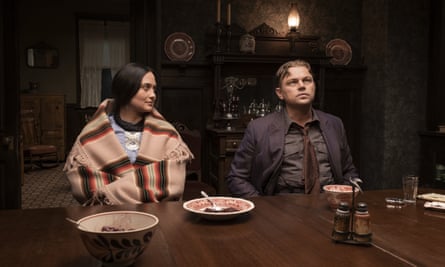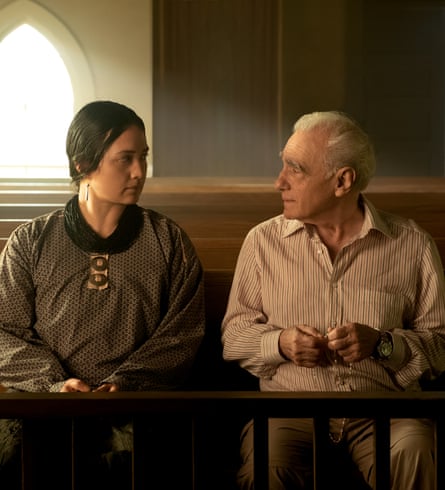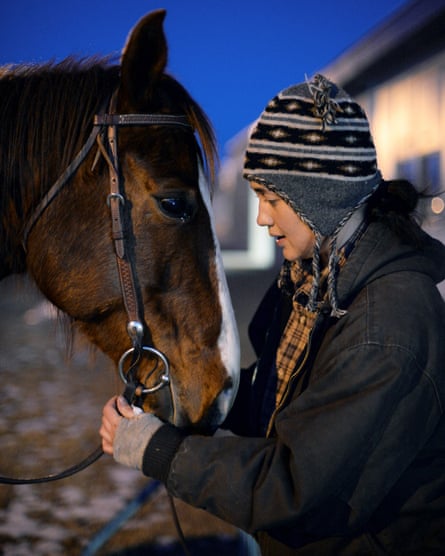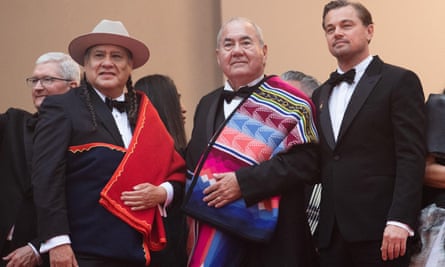As the race for the 2024 Oscars heats up, Martin Scorsese’s epic Killers of the Flower Moon, adapted from David Grann’s nonfiction 2017 book of the same name, is widely tipped as a frontrunner for the top prizes. Last month, the drama about the real-life Osage murders, masterminded by white men intent upon stealing the oil-rich land “headrights” of the Indigenous people in early 20th-century Oklahoma, topped Sight and Sound’s poll of best films of 2023. In the run-up to Christmas, Awards Daily placed Killers of the Flower Moon as the “best picture frontrunner”, while Variety named Scorsese and actor Lily Gladstone as probable Oscar nominees, with leading man and executive producer Leonardo DiCaprio (first nominated for What’s Eating Gilbert Grape in 1994 and winner for The Revenant in 2016) as on course for his eighth nomination.
With all this awards interest, it’s no surprise that DiCaprio and Gladstone are out on the campaign trail, finally able to talk about the film after the resolution of the actors’ strike, which prevented them from promoting it when it came out in the autumn. And while DiCaprio has a reputation for being less than fond of press interviews (we’ll get to the matter of his very public private life later), he’s clearly eager to support rising star Gladstone, who has much to say about the movie. Indeed, when I ask for somewhere to place my recording device, he goes into an elaborate comedic pantomime of moving a table, then a chair, then another table (“I should have just moved the chair first, shouldn’t I?”) before sitting well back in the sofa he shares with Gladstone and letting her take centre stage.
“It’s long overdue, this particular story,” says Gladstone of this saga of love, death and betrayal – in which a white man, Ernest Burkhart (DiCaprio), marries an Osage woman, Mollie Kyle (Gladstone), in order to inherit her family’s oil rights, against a backdrop of murder and exploitation. “The Osage community didn’t speak about it for such a long time – it’s such a fresh trauma. When David Grann’s book was written, it opened a lot of old wounds. But sometimes you need to open wounds to begin a healing process. The book is not taught in public schools in Oklahoma because teachers have been made too afraid to teach it on any curriculum. So it’s important to have a film out there that people can connect with and be shown as part of history. It’s a long-overdue moment of representation.”
For Gladstone, who grew up on the Blackfeet Nation reservation, and whose previous acting credits include Kelly Reichardt’s Certain Women and First Cow, the key to that “moment of representation” is the degree to which members of the Osage Nation were involved in the film’s development, and the number of Indigenous actors on screen. Indeed, she argues that the casting and production of Killers of the Flower Moon marks a watershed moment in Hollywood, with potential to change the industry.
“I think we will get a lot of other TV shows and films that are made by Native people,” she says, contrasting this with the portrayal of Indigenous people in “the era of the ‘classic western’ which relegated us to being bloodthirsty savages. We didn’t have our leading ladies in our sweeping, tragic love stories like classic old Hollywood. So placing this incredible Indigenous cast in these roles that we’ve been excluded from in film history is very restorative. We had so much Osage input into Killers of the Flower Moon, and that really shaped everything you see on screen. I hope this will set a new precedent for people working with communities in Hollywood.”

I ask DiCaprio – who has been listening intently to Gladstone, careful not to interrupt – about his role in reshaping the film’s script from its original inception, a key factor in Osage involvement in Killers of the Flower Moon. “Well, it was a long development process,” he sighs. “We got the option to the book, and that was particularly exciting for me, because it was this lost chapter of American history. And in a lot of the environmental work that I do [DiCaprio is a longstanding campaigner], you see Indigenous communities all around the world with similar stories. Some of these environmental heroes are at risk of perishing from major oil companies, drilling companies, mining companies. So this story is not something that we could just look at as being 100 years old. This was a place rich with oil and resources, and rife with conflict, and that’s happening everywhere now.”
Scorsese, who was equally interested in this “amazing story”, set about developing a script based on Grann’s book, much of which focuses on “the birth of the FBI”, in which Thomas Bruce White Sr (the law officer who led the Osage murders investigation) plays a key role. It was this role (ultimately played by Jesse Plemons) that was originally earmarked for DiCaprio. But “after a year or two of developing that, we started to have these read-throughs, and we just didn’t feel anything. Emotionally. I remember we had a roundtable before Lily was involved, and we kind of just looked at each other. And we’re like: ‘OK, well, this is a pretty great whodunnit.’ A Hitchcockian murder mystery. But I’m not interested in plot, I’m not interested in that type of structure.
“Then we started to look at these few scenes between Mollie and Ernest and we realised that was really the heartbeat of the story. That also brought us into the Osage world and community more, which led us to scrap the whole script and start anew. Then, after we got our new draft, which was largely based on films like A Place in the Sun and The Heiress – this very twisted, bizarre love story – Marty was invited by the Osage to listen more deeply to their story and their version of what happened. And then after Lily came on as well, the whole story started to take on an entirely new structure.”
So how exactly did Scorsese “listen more deeply” to the Osage people?
“Osage actually extended the invite,” Gladstone replies. “Gray Horse [an Osage County community] has had an eye on it since the book was written, and I knew that there was interest in the film. When it became clear that things were moving forward, and that it was going to be Leo and Marty doing it, they reached out – the community of Gray Horse got together and signed this letter saying: ‘Our community has a really strong vested interest in the story and its adaptation, and we just want to invite Mr Scorsese and the film-makers to come to our community and have dinner with us and discuss and hear some of our thoughts and concerns about the adaptation.’ And Marty accepted that invitation.”
Even with this Osage input, Killers of the Flower Moon still provoked its fair share of negative reactions. The Indigenous Canadian actor Devery Jacobs, who plays Elora in the TV series Reservation Dogs, took to social media to slam the film for being “painful, gruelling, unrelenting and unnecessarily graphic”, adding: “All the incredible Indigenous actors were the only redeeming factors of this film” and concluding, “After 100 years of the way Indigenous communities have been portrayed in film, is this really the representation we needed?”
Despite their best efforts, it seems the film-makers simply couldn’t please everybody.

“Well, art shouldn’t please everybody,” says Gladstone. “What matters to me most is that Osage people feel good about it. And by and large, the ones that I’ve spoken with, whether they were involved in making the film or not, are very supportive. Former chief Jim Gray was one of the most vocal opponents of it being made. He was very, very sceptical, as was a lot of the community. But after he’d seen the film, he released this really long, beautiful Twitter thread that was just such a glowing endorsement of what he had seen. That meant a lot to me, because Jim was somebody whose opinion I ended up really caring about. Some of my closest friends who weren’t involved in the film avoided me when I was in town because again, they were sceptical of what this film would do to sensationalise this really ugly chapter of the tribe’s history. And now it’s one of their favourite films! Of course, there’s going to be people in the Osage Nation who have different feelings too, but overwhelmingly it feels like there’s a lot of support. And there’s a protectiveness of the movie.”
In its finished form, Killers of the Flower Moon centres on a relationship that is clearly abusive – a white incomer marrying into an Indigenous community in order to inherit and steal the oil money that has made their land wealthy. Yet on screen, DiCaprio and Gladstone conjure a sense of intimacy between Ernest and Mollie that is at odds with that entirely exploitative narrative, hinting at something more tender beneath the surface. How would the actors characterise Ernest and Mollie’s relationship?
“It’s interesting,” muses DiCaprio, whose character is the biddable nephew of Robert De Niro’s oleaginous schemer William King Hale, one of the key instigators of the crimes against the Osage people. “This Mollie-Ernest dynamic was almost something that a writer couldn’t imagine. I mean, obviously this was an incredibly abusive relationship. But was there a real bond? You have this ecosystem in Oklahoma, where you have this massive white population, taking over what was Indigenous land. But after talking over and over with members of that community, they told us that while Hale has been literally erased from memory and history books because of the banality of evil that he was, Ernest was different. He was this sort of manipulated nephew of Hale’s. He’s obviously incredibly culpable. But we kept hearing over and over again that there was a real bond and connection between Ernest and Mollie – there was something there.”
I suggest that that sense of connection is crucial to the engagement of Scorsese’s film, and that without it, audiences may have felt disconnected from the twisted and duplicitous goings-on. If the whole thing is just a murderous setup, it’s hard to invest emotionally.
“Right!” says DiCaprio. “And it was there. So much so that even after the trial, Mollie and Ernest were still seen driving around Fairfax together. In other words, I couldn’t imagine this relationship having existed as long as it did unless there was a real relationship there.”
“There were lots of white men that married Osage women,” says Gladstone, “and lots of white women that married Osage men. And they would never have gone to the lengths of wanting to communicate with their spouses in their language. Ernest was a simple man who was illiterate; he wasn’t a great intellectual by any means.” (“By any means,” interjects DiCaprio, laughing.) “And yet he picked up the language and spoke it with this family, he spoke it with his kids. I think he found, as a lot of people do when they marry into Indian country, a very unconditionally accepting family. A very grounded, well-defined, impeccably maintained, communally maintained culture to belong to. And I think Ernest felt a great deal of belonging when he was with his family. But he also had this other culture he’d come from, this other entity, essentially this strong hand of the patriarchal overlord.”
Our conversation turns to activism and environmentalism – a subject close to them both. While Gladstone was recently quoted as saying “acting is my activism”, DiCaprio has become something of an eco-celebrity. In a poll conducted by the Hollywood consultancy the National Research Group of about 1,500 18- to 64-year-olds, DiCaprio was named the public figure or celebrity they most trusted on sustainability, ahead of Greta Thunberg, Al Gore, Dwayne “The Rock” Johnson and President Joe Biden.
“Look, I mean, I’ve been doing it for quite a long time now,” says DiCaprio. “And I’ve realised there’s been this great narrative perpetuated by, whether it be governments or the private sector, that it’s the individual’s responsibility. And by the way, that isn’t to say that that’s not true. I mean, we can do what we can from a local level; we can vote, there’s plenty of things that we can do. But governments need to change their policies, which is what all these Cops are about – holding nations and the private sector responsible for global emissions. We’re waiting for technologies like carbon sequestration; we’re waiting for AI supercomputers to give us these answers. This is the largest endeavour that civilisation and humanity has ever had to take on, and possibly the most important. We’re affecting every future generation and all life on Earth. Many people have said: ‘Oh, the Earth will still be around.’ But what kind of Earth will it be like to live in? For its inhabitants?
“So my focus right now is to ask: ‘How do we protect the natural world?’ You protect the stewards of the land, you protect the people on the ground, the local communities, the Indigenous people that have been doing this for thousands and thousands of years. So the whole focus of my foundation work now is the idea of saving nature by protecting, and funnelling 100% of all funds to the Indigenous groups on the ground. Giving local communities the means through which to protect these places, rather than extract from them, and to protect them from massive corporations that are there to cut down their trees for cattle farms, soy or palm oil. And by and large, by doing that, you protect all the biodiversity that coexists with that.”

“Regardless of politics,” says Gladstone, “that’s one thing I admire so much about Leo’s activism – it acknowledges human beings and grassroots efforts. Throughout the history of mankind we’ve always been subject to the whims of whatever our ruling body is saying. However the political pendulum swings, that human-level, grassroots resistance remains. There’s always going to be an Indigenous element, a people-based movement. It’s always going to be allies joining the people who, regardless of politics, are holding that frontline, maintaining the Earth, taking care of community. It’s sort of circumventing whatever government is doing and just addressing the direct needs of the people on this planet.”
Bearing in mind how vocal De Niro has been about the threat posed to the US and the world by Donald Trump, how alarmed or optimistic are they about the forthcoming American election?
“It’s a long answer,” says DiCaprio, who studiously avoids the kind of quotable anti-Trump soundbites with which his and Gladstone’s co-star has made headlines. “I have no idea what direction things are gonna go in. All I see is more and more polarisation on a number of different issues in our country. From an ecological perspective, there’s one party that I have sided with – it’s been traditionally the one that actually believes in 99% of the scientific community and their findings, which I happen to be a proponent of. I believe in science!
“I remember doing a film called Before the Flood, and I was with one of the Nasa scientists who, for the first time, gave me a map of planet Earth and literally said: ‘Look, you see everything along the equatorial line here?’ I’m like: ‘Yeah, that’s close to where I live in Los Angeles’, because this was seven years ago. ‘So you’re going to start to see fires pop up as the Earth starts to warm, things are going to start to incinerate, there’s going to be too much drought, the trees will not have enough resistance.’ And literally, a few years later, you’re starting to hear about massive forest fires. And now this is a regular thing. So we’re seeing everything else start to happen, almost to a T, that scientists have predicted. And we have one party that has systematically denied the scientific community and has not been a proponent of protecting our climate.”

In stark contrast to the unfolding catastrophe of the climate crisis, I ask if we can discuss more trivial matters. “Like, what’s your favourite colour?” laughs DiCaprio. No, like the actors’ strike. How did they each manage it?
There’s a long silence, eventually broken by Gladstone.
“It was frustrating to not be able to speak to the film,” she says wearily, “to really be out there representing it. But I will say that there was one silver lining that I hope also created a new precedent with films like this. Because the actors couldn’t talk, it was really nice to sit back and allow Osage people to take the carpet and speak first about it. I’m always looking for silver linings. It’s maybe a character strength, maybe a character flaw. But it was really inspiring. I mean, in some ways I feel like us actors have done our job when the film wraps – we pour everything into the character, we pour it into the story. There’s a huge conversation about what happens when a piece is done. Is it still yours or do you hand it over to the audience? And in that process of handing this art back to an audience, really back to Osage people first, it was appropriate that you heard those voices.”
Does DiCaprio feel the same?
“Look, Marty’s been out on the campaign trail because we haven’t been able to speak about it,” he replies. “But if I’m being quite honest, I really wanted to have Lily be able to have a pulpit to talk about this movie. And it’s been interesting to hear her perspective and what it means. So what can I say about the actors’ strike? Nobody worked! You know. And now, we’re gonna get back to work! And I’m glad it’s all over.”
Does DiCaprio ever get bothered by press interest in his personal life?
“As far as my personal life is concerned, you know, my answer is pretty simple. I got into this industry at a very young age. I felt incredibly compelled to do this. And the irony is that I was born and raised in Hollywood. People think:‘Oh, OK, just add water’, right? But I tried to become an actor multiple times and I got rejected. And at 12 or 13 years old, one of those agents said: ‘OK, we’ll give you a shot.’ Since then, it’s felt like winning the lottery. And to be honest, I would have been happy doing any sort of acting jobs – commercials, television.

“I got the one opportunity doing This Boy’s Life with Robert De Niro. I watched his work, realised the calibre of actor that he was and said to myself: ‘I will never squander this opportunity.’ So since then, a lot of other stuff comes hand in hand with that. The complete loss of your private life. And you know what, a lot of people have to deal with a lot harsher things than having their private life be public knowledge. That’s just one of the byproducts. I feel too lucky to do what I do to sit here and complain about it. It’s just one of the things you have to accept and you adapt.”
Our time is almost up and I have one last question for each of them: what’s the best thing about the other person? DiCaprio turns to Gladstone, clearly determined that she’s going to go first.
“Well, I’ve said it several times,” she says. “And it’s honestly the best compliment I can give somebody. He’s such a nerd! He gets so invested in everything he cares about. And he cares so deeply. He is humble about it, but it’s intriguing and awesome to see how excited and invested he gets in things.”
And Leonardo, what’s the best thing about Lily?
“There’s a lot of things that I could say,” he smiles, “but I think she’s a good person. I notice small things in people, and look, she does a lot of amazing activism. She’s great – I don’t want to get too deep into it – great to her family, great to her community. She’s a sort of scholar in a lot of ways of her own history. But I always watch the little things and she’s consistently an incredibly gracious and nice person to everybody.”
Gladstone looks genuinely moved. “Thank you,” she says quietly.
And since you brought it up, what is your favourite colour?
“I go back and forth between green and blue,” laughs Gladstone.
And you, Leonardo?
“Blue.”
“Can I ask you a question?” Lily says to him. “Is your favourite colour blue because of… Captain Planet?”
“It’s always been blue,” DiCaprio beams. “Probably because I’m just a boy.”
And they both fall about laughing.